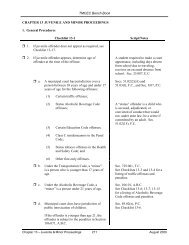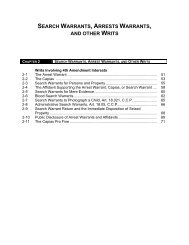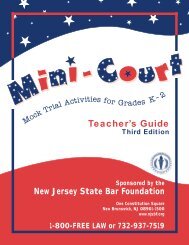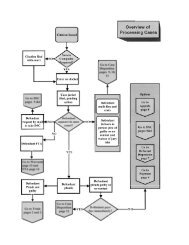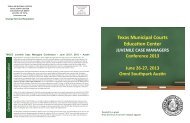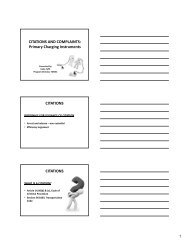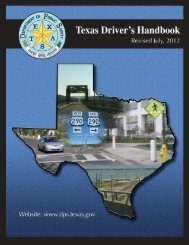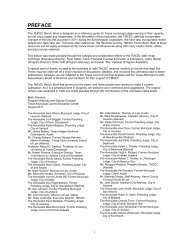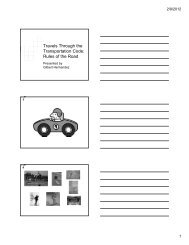ix.bond forfeitures - Texas Municipal Courts Education Center
ix.bond forfeitures - Texas Municipal Courts Education Center
ix.bond forfeitures - Texas Municipal Courts Education Center
You also want an ePaper? Increase the reach of your titles
YUMPU automatically turns print PDFs into web optimized ePapers that Google loves.
TMCEC Bench Book<br />
CHAPTER 9 BOND FORFEITURES<br />
2. Cash, Surety, or Personal Bond Forfeiture Procedures Under Chapter 22, C.C.P.<br />
Before a judgment nisi is issued initiating a <strong>bond</strong> forfeiture, a surety can be released from the<br />
responsibility on the <strong>bond</strong> by filing an affidavit of intention to surrender the defendant. The affidavit must<br />
include a statement that notice to the principal’s attorney has been given as required by Article. 17.19,<br />
C.C.P. See Arts. 17.16-17.19, C.C.P., for rules regarding discharge of liability on <strong>bond</strong>.<br />
An action by the State to forfeit a bail <strong>bond</strong> must be brought not later than the fourth anniversary of the<br />
date the principal fails to appear in court. Art. 22.18, C.C.P.<br />
Checklist 9-2<br />
Script/Notes<br />
Definitions:<br />
“Agreed judgment” is a judgment entered on agreement of the<br />
parties, which receives the sanction of the court. When the<br />
court gives the agreement its sanction, it becomes the<br />
judgment of the court.<br />
An “answer” is the formal written statement made by a<br />
defendant setting forth grounds for his or her defense. In some<br />
instances may need to be verified (sworn to).<br />
A “citation” is a writ (written order) issued by the clerk of the<br />
court. The citation notifies a person of a lawsuit filed against<br />
him or her and directs the person to file an answer to the suit<br />
within a certain number of days.<br />
“Defendant” is a term used to describe the surety.<br />
“Forfeiture” means the signing of the judgment nisi.<br />
“Judgment nisi” is a temporary order which will become final<br />
unless the defendant in the criminal case and/or the surety<br />
show good cause why the judgment should be set aside.<br />
“Judicial notice” is an act by which a court, in conducting a<br />
trial, will, without the production of evidence, recognize the<br />
existence and truth of certain facts or documents because the<br />
court already is aware of the facts or documents.<br />
A “movant” is one who makes a motion before a court.<br />
“Pleadings” are formal allegations by parties of their<br />
respective claims and defenses.<br />
A “principal” is the defendant in the criminal case.<br />
“Scire Facias” is a special docket required by law to handle all<br />
cases and proceedings involved in the forfeiture of bail <strong>bond</strong>s.<br />
Art. 22.10, C.C.P.<br />
Chapter 9 - Bond Forfeitures 185 August 2011



